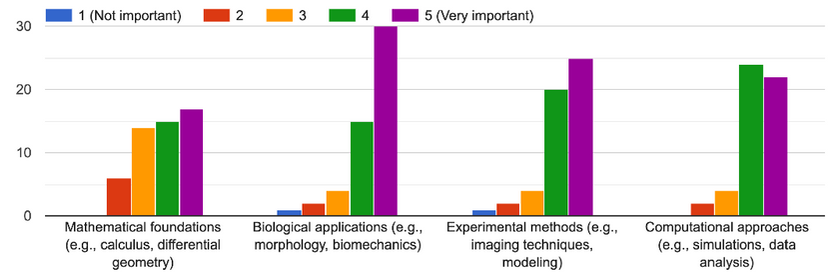
Teaching
In spring 2025, Working Group 1 asked the Action members to fill in a questionnaire to identify: 1) the interests in the Action, 2) what skill-sets are available and 3) what research topics we are all working on.
The results of this survey enabled the creation of a curriculum that could help to train each other to be able to connect and hopefully solve important problems together, in our respective fields.
Survey
The survey stayed online March 7 - 31, 2025, and had 52 replies within EuroCurvoBioNet. Most of the replies came from faculty members (lecturers/professors) (63.5%) and researchers with a doctorate degree (88.9%), predominantly from the areas of Biology, Engineering and Physics; this reflects the major fields of this community, and a strong establishment in academia. covered were agreed on, and study groups for each topic were constructed.
What is your primary field of study?

It is interesting to note that there is a 50-50 division in what concerns to experience in computational modelling skills; but the majority of the participants has experimental skills. This leads to the first proposal out of this survey, which is to enhance the offer of educational materials on computational modelling related to curvature in biology. On this note, it is also noticeable that a significant part of the community (almost 40%) is still to conduct research related to curvature in biology, so this offer of a computational curriculum could be the starting point to expand that research area within this community.
Regarding the knowledge on key concepts, those related to fluids (e.g., complex fluids or fluid dynamics) are less represented in the community, while tissue engineering, mechanobiology or mathematical modelling in biology are more strongly established. This is in agreement with the fields initially declared to be challenging by the participants in this survey.
How would you rate the importance of the following topics in a curriculum on curvature in biology ?

Computational and imaging techniques, mechanobiology and statistical analysis are the most relevant techniques, with bioengineering, microbiology, animal cell culture, plant cell culture and design and fabrication being represented to lesser extends. Despite the above-mentioned experimental background, cell culture education is expected to be promoted within the community, along with the computational techniques (e.g., computational simulations).
Workshops/seminars, collaborative research opportunities and research visits/mobility were reported to have potential to enhance the knowledge in these less represented areas. Furthermore, lectures and hands-on experiments would also help disseminating interdisciplinary topics related to curvature in biology, and this would only be possible through collaborative research networks and mobility within such networks. Such direction is aligned with the objectives of this COST action. Nevertheless, there is an undeniable tendency for knowledge to be shared through online courses; one could extrapolate that making learning materials available online could be a first step towards the consolidation of the concepts (and the whole community), with hands-on workshops/laboratories being a second step.
What resources do you prefer for learning?

To conclude this report, it must be highlighted that the majority of the participants expressed their availability to teach on a curriculum dedicated to curvature in biology, or to contribute actively to such curriculum, although the majority declared having no previous experience with teaching courses directly related to the field. Names and emails were collected (upon authorisation), so that these members of the community can be contacted to establish learning materials aligned with the outputs of this survey. During a 2,5 hours WG1 meeting (hybrid) in Prague on July 1st, the survey results were discussed, and a curriculum based on the survey results was drafted. The main topics to be covered were agreed on, and study groups for each topic were constructed.
Curriculum
Four modules of 8 hours are currently being designed. The lectures will be delivered online and recorded to allow the constitution of a pedagogic platform that can be visited later, beyond the lifetime of the Action.
Module | Hours | Module Leader |
|---|---|---|
Curvature across scales and applications | 8 | Ana Casimiro |
Imaging techniques and applications | 8 | Alexey Bondar |
Mechanobiology | 8 | Nicholas A. Kurniawan |
Mathematical modelling for biology | 8 | Javier Buceta |





